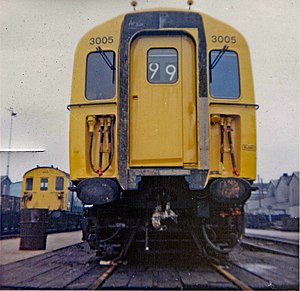British Rail Class 432
| British Rail Class 432 (4-REP) | |
|---|---|

4-REP no. 3005 "ex-works" at Eastleigh Works, 22 October 1973
|
|
| In service | 1966–1992 |
| Manufacturer | British Rail |
| Built at | York Works |
| Family name | BR Mark 1 EMU |
| Constructed | 1966–1967, 1974 |
| Number built | 15 sets |
| Formation | 4 cars: DMSO-TRB-TBFK-DMSO |
| Fleet numbers | 3001–3015, later 2001–2015 |
| Capacity | 24 First, 128 Standard, 23 buffet seats |
| Operator(s) | Southern Region of British Rail |
| Depot(s) | |
| Line(s) served | London Waterloo – Bournemouth |
| Specifications | |
| Car length |
|
| Width | 2.82 m (9 ft 3 in) |
| Maximum speed | 90 mph (145 km/h) |
| Weight |
|
| Traction motors | Eight EE546 |
| Power output | 8 x 300 kW (400 hp) Total: 2,400 kW (3,200 hp) |
| Electric system(s) | 750 V DC third rail |
| Current collection method | Contact shoe |
| UIC classification | Bo′Bo′+2′2′+2′2′+Bo′Bo′ |
| Braking system(s) | Air (Auto and Electro-Pneumatic) |
| Safety system(s) | Automatic Warning System |
| Track gauge | 1,435 mm (4 ft 8 1⁄2 in) standard gauge |
The British Rail 4-REP electric multiple-unit passenger trains were built by BR at York Works from 1966 to 1967 and in 1974. The units were built to power the TC trailer units on services on the South Western Main Line. Fifteen four-car units were eventually built. The motor coaches were new build, but the trailers were converted from Mk1 hauled stock. They were initially classified as Class 441 and numbered 3001–3015. This was later changed to Class 430, under which they spent the majority of their working lives. Shortly before withdrawal they were reclassified Class 432 and the units were renumbered as 2001–2015. The fleet had a lifespan of 26 years.
With the withdrawal of steam services and the full electrification of the line to Bournemouth on 9 July 1967, there had been insufficient financial justification to electrify between Bournemouth and Weymouth. This resulted in a quandary of how to maintain through services and the solution devised was novel. Tests in the mid 1960s had proved that high speed main line push-pull operation was both feasible and safe. The result was to have a high powered 4-car EMU at the London end pushing trailer units to Bournemouth where the trailers would be detached and then pulled to Weymouth by a push-pull equipped diesel electric locomotive. The operation in the up direction would be the reverse.
The whole scheme also revealed a need for a small batch of locomotives to maintain connecting services between London (Waterloo) and the unelectrified area of Southampton Docks for the passenger Ocean Liner traffic. This need exceeded the capabilities of the already extant and versatile Class 73 Electro-diesels (1600 hp on electric & 600 hp on diesel) which provided motive power across the region for numerous secondary duties requiring locomotive haulage. To provide for this need, and keep the whole scheme within the limited budget available it was decided that 10 Class 71 2,550 hp straight electric locomotives operating on the South Eastern Division of the Region in the Kent area, that had become excess to operating needs be converted to Class 74. The alterations turned these locomotives into another Electro-diesel type with 2,550 hp on electric and 650 hp on diesel. As it transpired the locomotives as altered were fairly unreliable, and the Ocean Liner traffic for which they were primarily intended was rapidly vanishing. They were therefore a short lived type that was introduced from late 1967 and withdrawn within 10 years.
...
Wikipedia
